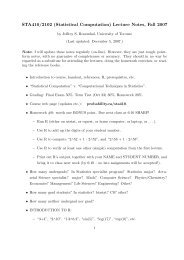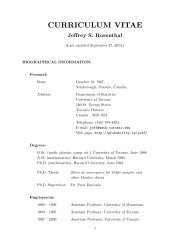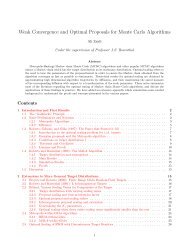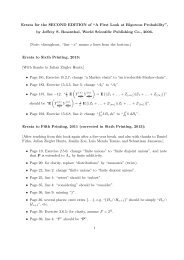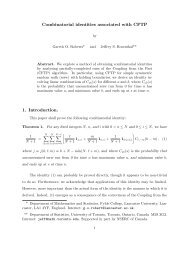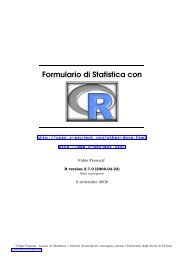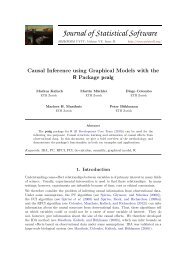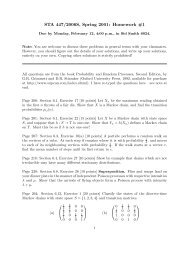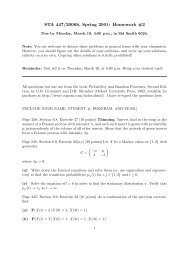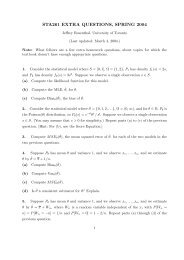Package 'extRemes' - What are R and CRAN?
Package 'extRemes' - What are R and CRAN?
Package 'extRemes' - What are R and CRAN?
Create successful ePaper yourself
Turn your PDF publications into a flip-book with our unique Google optimized e-Paper software.
40 fevd<br />
3. “qq”: Empirical quantiles against model quantiles. Again, a good fit will yield a straight oneto-one<br />
line of points. Generally, the qq-plot is preferred to the probability plot in 1 above. As<br />
in 2, for the non-stationary case, data <strong>are</strong> first transformed <strong>and</strong> plotted against quantiles from the<br />
st<strong>and</strong>ardized distributions. Also as in 2 above, in the case of the PP model, parameters <strong>are</strong> converted<br />
to those of the GP df <strong>and</strong> quantiles <strong>are</strong> from threshold excesses of the data.<br />
4. “qq2”: Similar to 3, first data <strong>are</strong> simulated from the fitted model, <strong>and</strong> then the qq-plot between<br />
them (using the function qqplot from this self-same package) is made between them, which also<br />
yields confidence b<strong>and</strong>s. Note that for a good fitting model, this should again yield a straight oneto-one<br />
line of points, but generally, it will not be as “well-behaved” as the plot in 3. The one-to-one<br />
line <strong>and</strong> a regression line fitting the quantiles is also shown. In the case of a non-stationary model,<br />
simulations <strong>are</strong> obtained by simulating from an appropriate st<strong>and</strong>ardized EVD, re-ordered to follow<br />
the same ordering as the data to which the model was fit, <strong>and</strong> then back transformed using the<br />
covariates from data <strong>and</strong> the parameter estimates to put the simulated sample back on the original<br />
scale of the data. The PP model is h<strong>and</strong>led analogously as in 2 <strong>and</strong> 3 above.<br />
5. <strong>and</strong> 6. “Zplot”: These <strong>are</strong> for PP model fits only <strong>and</strong> <strong>are</strong> based on Smith <strong>and</strong> Shively (1995, see<br />
also http://www.stat.unc.edu/postscript/rs/var.pdf). The Z plot is a diagnostic for determining<br />
whether or not the r<strong>and</strong>om variable, Zk, defined as the (possibly non-homogeneous) Poisson<br />
intensity parameter(s) integrated from exceedance time k - 1 to exceedance time k (beginning the<br />
series with k = 1) is independent exponentially distributed with mean 1.<br />
For the Z plot, it is necessary to scale the Poisson intensity parameter appropriately. For example,<br />
if the data <strong>are</strong> given on a daily time scale with an annual period basis, then this parameter should be<br />
divided by, for example, 365.25. From the fitted fevd object, the function will try to account for the<br />
correct scaling based on the two components “period.basis” <strong>and</strong> “time.units”. The former currently<br />
must be “year” <strong>and</strong> the latter must be one of “days”, “months”, “years”, “hours”, “minutes” or<br />
“seconds”. If none of these <strong>are</strong> valid for your specific data (e.g., if an annual basis is not desired),<br />
then use the d argument to explicitly specify the correct scaling.<br />
7. “hist”: A histogram of the data is made, <strong>and</strong> the model density is shown with a blue dashed line.<br />
In the case of non-stationary models, the data <strong>are</strong> first transformed to an appropriate st<strong>and</strong>ardized<br />
EVD scale, <strong>and</strong> the model density line is for the self-same st<strong>and</strong>ardized EVD. Currently, this does<br />
not work for non-stationary POT models.<br />
8. “density”: Same as 5, but the kernel density (using function density) for the data is plotted<br />
instead of the histogram. In the case of the PP model, block maxima of the data <strong>are</strong> calculated <strong>and</strong><br />
the density of these block maxima <strong>are</strong> comp<strong>are</strong>d to the PP in terms of the equivalent GEV df. If the<br />
model is non-stationary GEV, then the transformed data (to a stationary Gumbel df) <strong>are</strong> used. If the<br />
model is a non-stationary POT model, then currently this option is not available.<br />
9. “rl”: Return level plot. This is done on the log-scale for the abscissa in order that the type<br />
of EVD can be discerned from the shape (i.e., heavy tail distributions <strong>are</strong> concave, light tailed<br />
distributions <strong>are</strong> straight lines, <strong>and</strong> bounded upper-tailed distributions <strong>are</strong> convex, asymptoting at<br />
the upper bound). 95 percent CIs <strong>are</strong> also shown (gray dashed lines). In the case of non-stationary<br />
models, the data <strong>are</strong> plotted as a line, <strong>and</strong> the “effective” return levels (by default the 2-period (i.e.,<br />
the median), 20-period <strong>and</strong> 100-period <strong>are</strong> used; period is usually annual) <strong>are</strong> also shown (see, e.g.,<br />
Gillel<strong>and</strong> <strong>and</strong> Katz, 2011). In the case of the PP model, the equivalent GEV df (stationary model)<br />
is assumed <strong>and</strong> data points <strong>are</strong> block maxima, where the blocks <strong>are</strong> determined from information<br />
passed in the call to fevd. In particular, the span argument (which, if not passed by the user, will<br />
have been determined by fevd using time.units along with the number of points per year (which<br />
is estimated from time.units) <strong>are</strong> used to find the blocks over which the maxima <strong>are</strong> taken. For<br />
the non-stationary case, the equivalent GP df is assumed <strong>and</strong> parameters <strong>are</strong> converted. This helps



